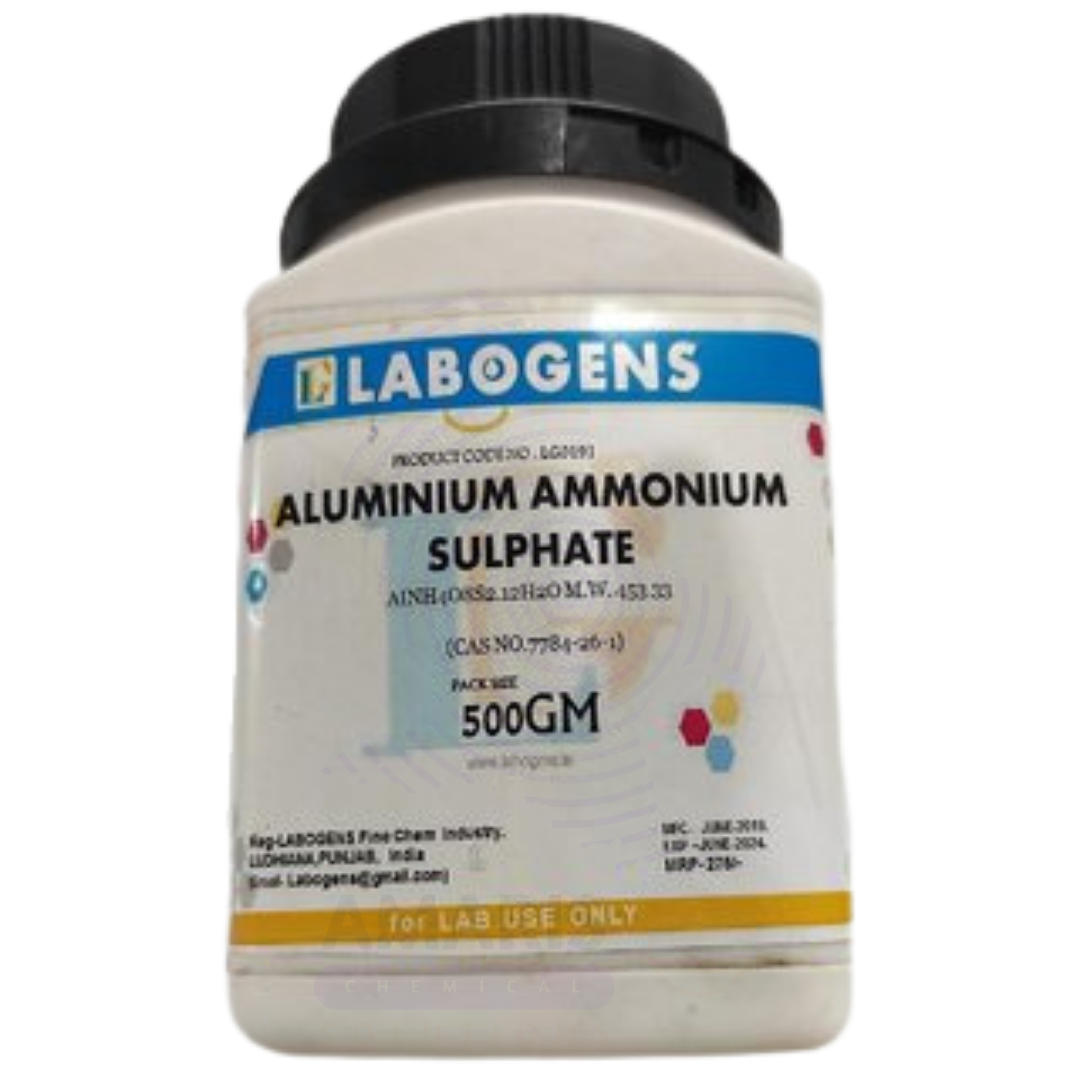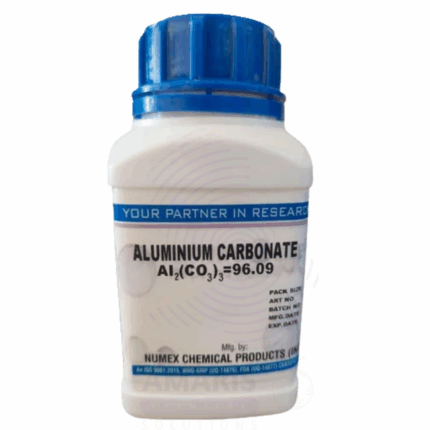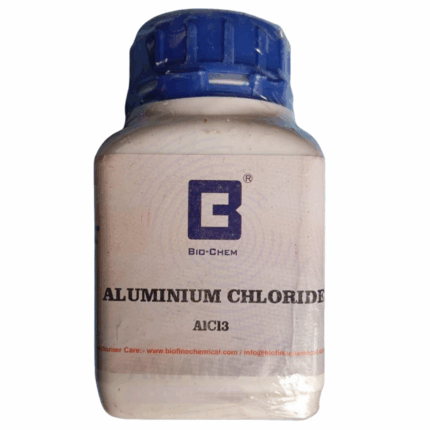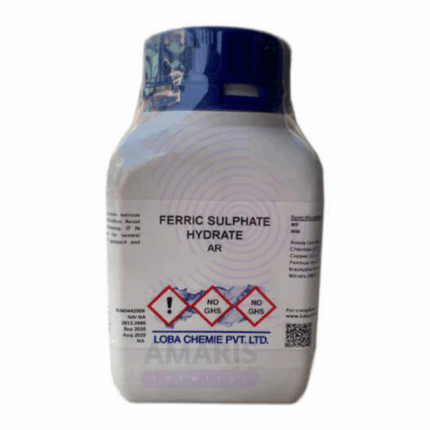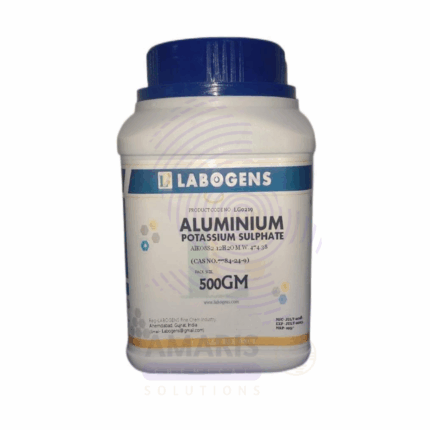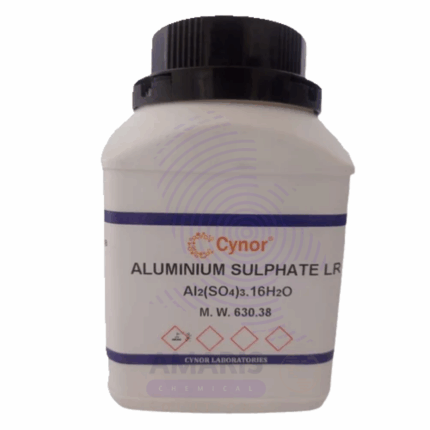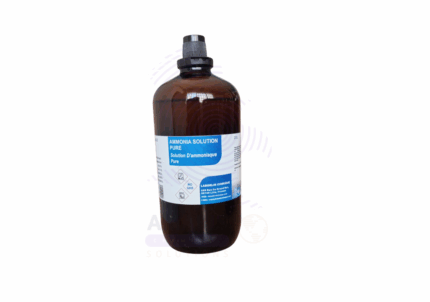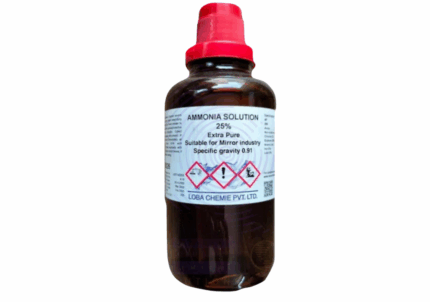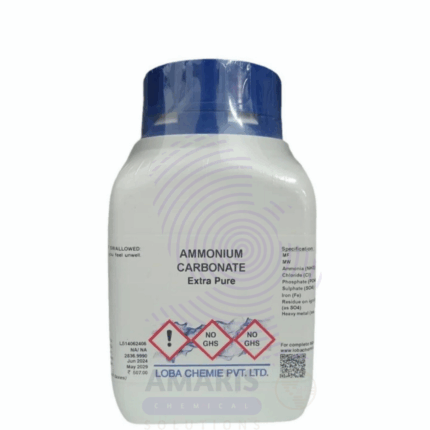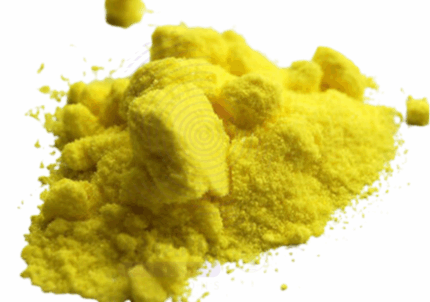
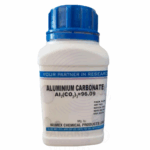
Aluminium Ammonium Sulphate Extra Pure
$ 18.00 Original price was: $ 18.00.$ 17.83Current price is: $ 17.83.
Aluminium Ammonium Sulphate Extra Pure, also known as ammonium alum, is a high-purity double salt composed of aluminum sulfate and ammonium sulfate, typically appearing as colorless or white crystalline granules. Valued for its excellent stability and solubility in water, it is widely used in analytical chemistry, dye mordanting, and laboratory reagent preparations. Its ability to precipitate proteins makes it useful in biochemical applications, while its astringent and antimicrobial properties support its role in pharmaceutical and cosmetic formulations. The extra pure grade ensures minimal impurities, making it suitable for high-precision scientific work. It should be stored in a tightly sealed container in a dry, cool area to prevent moisture absorption and maintain its effectiveness.
Aluminium Ammonium Sulphate Extra Pure
Primary Uses
- Analytical Reagent in Laboratories
- Used in qualitative and quantitative analysis, especially for detecting alkali and alkaline earth metals.
- Precipitant in Protein Purification
- Facilitates “salting out” of proteins in biochemistry and enzyme isolation protocols.
- Chromatographic Separation Support
- Utilized in specialized ion-exchange and inorganic separation processes.
- Chemical Reagent for Teaching and Demonstration
- Demonstrates crystallization, ionic bonding, and alum formation in educational chemistry.
- Buffering Agent in pH-Controlled Reactions
- Used in maintaining mildly acidic conditions in controlled lab reactions.
Secondary Uses
- Crystal Growth Experiments
- Ideal for growing transparent, large alum crystals in educational or research settings.
- Electroplating & Electrochemistry R&D
- Used in experimental studies involving aluminum ion baths or electrochemical reactions.
- Histological Fixatives
- May be used in classical or modified fixative formulations for microscopy slide prep.
- Cosmetic Testing
- Studied for its astringent and antimicrobial properties in lab formulations of deodorants or aftershaves.
- Water Treatment Simulations (Lab Scale)
- Studied in flocculation and coagulation experiments simulating alum-based water purification.
| PACK SIZE |
500 grams Plastic Tin |
|---|
1. Basic Identification Attributes
- Chemical Name: Aluminium Ammonium Sulphate (IUPAC: Ammonium aluminium sulfate dodecahydrate)
- CAS Number: 7784-26-1
- HS Code: 28333000
- Molecular Formula: NH₄Al(SO₄)₂·12H₂O
- Synonyms:
- Ammonium alum
- Aluminum ammonium sulfate dodecahydrate
- Ammonium aluminum alum
- Dialuminum ammonium disulfate
- Ammonium alum crystal
2. Physical & Chemical Properties
- Physical State: Solid (crystalline powder or granules)
- Color & Odor: Colorless to white crystals; odorless
- Boiling Point: Decomposes before boiling
- Melting Point: ~93.5°C (releases water of hydration)
- Density/Specific Gravity: ~1.64 g/cm³
- Solubility:
- Water: Soluble (approx. 14.6 g/100 mL at 20°C)
- Organic Solvents: Insoluble in alcohol, acetone
- pH Level: ~3.0–4.0 (in 5% aqueous solution – acidic)
- Vapor Pressure & Volatility: Non-volatile
- Flash Point: Not flammable
- Autoignition Temperature: Not applicable
- Viscosity: Not applicable (solid)
3. Safety & Hazard Attributes
- Hazard Class (GHS):
- Not classified as hazardous under GHS
- May cause skin and eye irritation
- NFPA Ratings:
- Health: 1
- Flammability: 0
- Reactivity: 0
- Exposure Limits:
- No specific OSHA PEL or ACGIH TLV
- Reactivity:
- Stable under normal conditions
- Incompatible with strong acids and strong bases (may release ammonia or sulfur oxides)
4. Storage & Handling Attributes
- Storage Conditions:
- Store in a cool, dry, and well-ventilated area
- Protect from moisture and incompatible substances
- Incompatible Materials:
- Strong oxidizing agents, strong acids, alkalis
- Container Type:
- Plastic-lined fiber drums or HDPE containers
- Shelf Life & Expiration Date:
- 2–3 years if kept dry and sealed
- Special Handling Requirements:
- Avoid creating dust
- Wear gloves and safety goggles during handling
5. Regulatory & Compliance Attributes
- Regulatory Status:
- Listed under TSCA, REACH
- GRAS status in food applications (limited use)
- Hazard Symbols (GHS Pictograms):
- None required under standard classification
- Transportation Restrictions:
- Not regulated for transport
- No UN number assigned
- Waste Disposal Method:
- Dispose of in accordance with local regulations
- Suitable for landfill or neutralization depending on volume
6. Environmental & Health Impact
- Ecotoxicity:
- Low aquatic toxicity at normal levels
- Excessive use may affect pH and aquatic systems
- Persistence in Environment:
- Dissolves in water; not environmentally persistent in moderate quantities
- Carcinogenicity/Mutagenicity:
- Not classified as carcinogenic or mutagenic by IARC or OSHA
- Biodegradability:
- Inorganic salt – does not biodegrade but dissociates in water
SAFETY PRECAUTIONS
- Personal Protective Equipment (PPE):
- Wear chemical-resistant gloves, safety goggles, and a lab coat.
- Use a dust mask or respirator if handling large amounts or if dust is generated.
- Handling:
- Avoid inhalation of dust and prevent contact with eyes or skin.
- Use only in well-ventilated areas.
- Handle gently to avoid creating airborne dust.
- Storage:
- Store in a tightly sealed container in a cool, dry, and well-ventilated place.
- Keep away from moisture, acids, and incompatible substances such as strong oxidizers.
- Hygiene Measures:
- Wash hands thoroughly after handling.
- Do not eat, drink, or smoke in handling areas.
- Clean clothing and PPE after use.
FIRST AID MEASURES
- Inhalation:
- Move to fresh air immediately.
- If breathing is difficult, administer oxygen.
- Seek medical attention if symptoms like coughing or irritation develop.
- Skin Contact:
- Wash affected area with soap and plenty of water.
- Remove any contaminated clothing.
- If irritation occurs, get medical attention.
- Eye Contact:
- Flush eyes with plenty of water for at least 15 minutes.
- Lift upper and lower eyelids occasionally while rinsing.
- Seek medical attention if irritation persists.
- Ingestion:
- Rinse mouth with water.
- Do not induce vomiting.
- Seek immediate medical attention, especially if large amounts are swallowed.
FIRE FIGHTING MEASURES
- Suitable Extinguishing Media:
- Use water spray, dry chemical powder, carbon dioxide (CO₂), or foam.
- Specific Hazards:
- Non-combustible, but may decompose upon heating to release irritating or toxic gases such as ammonia, sulfur oxides, and aluminum oxides.
- May contribute to corrosion when involved in fire runoff.
- Protective Equipment for Firefighters:
- Wear self-contained breathing apparatus (SCBA).
- Use full protective clothing resistant to chemicals.
- Firefighting Instructions:
- Keep containers cool with water spray if exposed to fire.
- Avoid inhalation of decomposition products.
- Contain and control runoff to prevent environmental contamination.
Related products
Aluminium Carbonate Extra Pure
Aluminium Chloride Anhydrous Extra Pure
Aluminium Ferric Sulphate Extra Pure
Aluminium Potassium Sulphate Hydrated Extra Pure
Aluminium Sulphate Anhydrous Extra Pure
Ammonia Solution Extra Pure
Ammonium Carbonate Extra Pure
Ammonium Carbonate Extra Pure is a high-quality, white crystalline solid widely used across various scientific, industrial, and food-related applications. Manufactured to stringent purity standards, this compound is ideal for laboratories and processes that demand high-grade reagents. With its characteristic ammonia-like odor and ability to decompose upon heating, ammonium carbonate plays a versatile role in both chemical reactions and physical processes.
In aqueous solution, ammonium carbonate breaks down into ammonium bicarbonate and ammonium carbamate, further releasing ammonia (NH₃) and carbon dioxide (CO₂) upon heating. This property makes it especially useful in applications that require controlled gas release or temporary pH modification.


 Preservatives(food)
Preservatives(food) Flavor Enhancers
Flavor Enhancers Acidulants
Acidulants Sweeteners
Sweeteners Antioxidants
Antioxidants Colorants(food)
Colorants(food) Nutraceutical Ingredients (food)
Nutraceutical Ingredients (food) Nutrient Supplements
Nutrient Supplements Emulsifiers
Emulsifiers
 Collectors
Collectors Dust Suppressants
Dust Suppressants Explosives and Blasting Agents
Explosives and Blasting Agents Flocculants and Coagulants
Flocculants and Coagulants Frothers
Frothers Leaching Agents
Leaching Agents pH Modifiers
pH Modifiers Precious Metal Extraction Agents
Precious Metal Extraction Agents
 Antioxidants(plastic)
Antioxidants(plastic) Colorants (Pigments, Dyes)
Colorants (Pigments, Dyes) Fillers and Reinforcements
Fillers and Reinforcements Flame Retardants
Flame Retardants Monomers
Monomers Plasticizers
Plasticizers Polymerization Initiators
Polymerization Initiators Stabilizers (UV, Heat)
Stabilizers (UV, Heat)
 Antifoaming Agents
Antifoaming Agents Chelating Agents
Chelating Agents Coagulants and Flocculants
Coagulants and Flocculants Corrosion Inhibitors
Corrosion Inhibitors Disinfectants and Biocides
Disinfectants and Biocides Oxidizing Agents
Oxidizing Agents pH Adjusters
pH Adjusters Scale Inhibitors( water)
Scale Inhibitors( water)
 Antioxidants(cosmetic)
Antioxidants(cosmetic) Emollients
Emollients Fragrances and Essential Oils
Fragrances and Essential Oils Humectants
Humectants Preservatives
Preservatives Surfactants(cosmetic)
Surfactants(cosmetic) Thickeners
Thickeners UV Filters
UV Filters
 Fertilizers
Fertilizers Soil Conditioners
Soil Conditioners Plant Growth Regulators
Plant Growth Regulators Animal Feed Additives
Animal Feed Additives Biostimulants
Biostimulants Pesticides (Herbicides, Insecticides, Fungicides)
Pesticides (Herbicides, Insecticides, Fungicides)
 Active Pharmaceutical Ingredients (APIs)
Active Pharmaceutical Ingredients (APIs) Excipients
Excipients Solvents(pharmaceutical)
Solvents(pharmaceutical) Antibiotics
Antibiotics Antiseptics and Disinfectants
Antiseptics and Disinfectants Vaccine Adjuvants
Vaccine Adjuvants Nutraceutical Ingredients (pharmaceutical)
Nutraceutical Ingredients (pharmaceutical) Analgesics & Antipyretics
Analgesics & Antipyretics
 Analytical Reagents
Analytical Reagents Solvents(lab)
Solvents(lab) Chromatography Chemicals
Chromatography Chemicals Spectroscopy Reagents
Spectroscopy Reagents microbiology-and-cell-culture-reagents
microbiology-and-cell-culture-reagents Molecular Biology Reagents
Molecular Biology Reagents Biochemical Reagents
Biochemical Reagents Inorganic and Organic Standards
Inorganic and Organic Standards Laboratory Safety Chemicals
Laboratory Safety Chemicals Specialty Laboratory Chemicals(Special Laboratory Equipment)
Specialty Laboratory Chemicals(Special Laboratory Equipment)
 Demulsifiers
Demulsifiers Hydraulic Fracturing Fluids
Hydraulic Fracturing Fluids Scale Inhibitors(oil)
Scale Inhibitors(oil) Surfactants(oil)
Surfactants(oil) Drilling Fluids
Drilling Fluids
 Dyes and Pigments
Dyes and Pigments Bleaching Agents
Bleaching Agents Softening Agents
Softening Agents Finishing Agents
Finishing Agents Antistatic Agents
Antistatic Agents
 Admixtures
Admixtures Waterproofing Agents
Waterproofing Agents Sealants and Adhesives
Sealants and Adhesives Curing Compounds
Curing Compounds Concrete Repair Chemicals
Concrete Repair Chemicals Anti-Corrosion Coatings
Anti-Corrosion Coatings
 Surfactants(cleaning)
Surfactants(cleaning) Builders
Builders Enzymes
Enzymes Solvents (Cleaning)
Solvents (Cleaning) Fragrances
Fragrances
 Electronic Chemicals
Electronic Chemicals Catalysts
Catalysts Lubricants
Lubricants Photographic Chemicals
Photographic Chemicals Refrigerants
Refrigerants Automotive chemicals
Automotive chemicals Pyrotechnic Chemicals
Pyrotechnic Chemicals
 Biodegradable Surfactants
Biodegradable Surfactants Bio-based Solvents
Bio-based Solvents Renewable Polymers
Renewable Polymers Carbon Capture Chemicals
Carbon Capture Chemicals Wastewater Treatment Chemicals
Wastewater Treatment Chemicals
 Pigments
Pigments Solvents(paint)
Solvents(paint) Specialty Coatings
Specialty Coatings Binders/Resins
Binders/Resins Additives
Additives Driers
Driers Anti-Corrosion Agents
Anti-Corrosion Agents Functional Coatings
Functional Coatings Application-Specific Coatings
Application-Specific Coatings
 Fresh Herbs
Fresh Herbs Ground Spices
Ground Spices Whole Spices
Whole Spices Spice Blends
Spice Blends Dried Herbs
Dried Herbs
 Leavening Agents
Leavening Agents Dough Conditioners
Dough Conditioners Flour Treatments
Flour Treatments Fat Replacers
Fat Replacers Decoratives
Decoratives Preservatives(baking)
Preservatives(baking)
 Plasticizers & Softeners
Plasticizers & Softeners Reinforcing Agents
Reinforcing Agents Adhesion Promoters
Adhesion Promoters Vulcanizing Agents
Vulcanizing Agents Antidegradants
Antidegradants Blowing Agents
Blowing Agents Fillers & Extenders
Fillers & Extenders Accelerators & Retarders
Accelerators & Retarders